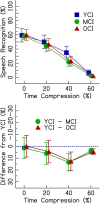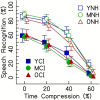The recognition of time-compressed speech as a function of age in listeners with cochlear implants or normal hearing
- PMID: 36247992
- PMCID: PMC9557069
- DOI: 10.3389/fnagi.2022.887581
The recognition of time-compressed speech as a function of age in listeners with cochlear implants or normal hearing
Abstract
Speech recognition is diminished when a listener has an auditory temporal processing deficit. Such deficits occur in listeners over 65 years old with normal hearing (NH) and with age-related hearing loss, but their source is still unclear. These deficits may be especially apparent when speech occurs at a rapid rate and when a listener is mostly reliant on temporal information to recognize speech, such as when listening with a cochlear implant (CI) or to vocoded speech (a CI simulation). Assessment of the auditory temporal processing abilities of adults with CIs across a wide range of ages should better reveal central or cognitive sources of age-related deficits with rapid speech because CI stimulation bypasses much of the cochlear encoding that is affected by age-related peripheral hearing loss. This study used time-compressed speech at four different degrees of time compression (0, 20, 40, and 60%) to challenge the auditory temporal processing abilities of younger, middle-aged, and older listeners with CIs or with NH. Listeners with NH were presented vocoded speech at four degrees of spectral resolution (unprocessed, 16, 8, and 4 channels). Results showed an interaction between age and degree of time compression. The reduction in speech recognition associated with faster rates of speech was greater for older adults than younger adults. The performance of the middle-aged listeners was more similar to that of the older listeners than to that of the younger listeners, especially at higher degrees of time compression. A measure of cognitive processing speed did not predict the effects of time compression. These results suggest that central auditory changes related to the aging process are at least partially responsible for the auditory temporal processing deficits seen in older listeners, rather than solely peripheral age-related changes.
Keywords: aging; behavior; cochlear implant; fast speech; hearing loss; speech perception; temporal processing; time compression.
Copyright © 2022 Tinnemore, Montero, Gordon-Salant and Goupell.
Conflict of interest statement
The authors declare that the research was conducted in the absence of any commercial or financial relationships that could be construed as a potential conflict of interest.
Figures




Similar articles
-
The effects of aging on speech perception in noise: comparison between normal-hearing and cochlear-implant listeners.J Am Acad Audiol. 2014 Jul-Aug;25(7):656-65. doi: 10.3766/jaaa.25.7.4. J Am Acad Audiol. 2014. PMID: 25365368
-
Spectral-Temporal Trade-Off in Vocoded Sentence Recognition: Effects of Age, Hearing Thresholds, and Working Memory.Ear Hear. 2020 Sep/Oct;41(5):1226-1235. doi: 10.1097/AUD.0000000000000840. Ear Hear. 2020. PMID: 32032222 Free PMC article.
-
Effects of age on melody and timbre perception in simulations of electro-acoustic and cochlear-implant hearing.Ear Hear. 2014 Mar-Apr;35(2):195-202. doi: 10.1097/AUD.0b013e3182a69a5c. Ear Hear. 2014. PMID: 24441739 Free PMC article.
-
Temporal envelope changes of compression and speech rate: combined effects on recognition for older adults.J Speech Lang Hear Res. 2007 Oct;50(5):1123-38. doi: 10.1044/1092-4388(2007/078). J Speech Lang Hear Res. 2007. PMID: 17905900
-
Recognition of time-distorted sentences by normal-hearing and cochlear-implant listeners.J Acoust Soc Am. 2001 Jan;109(1):379-84. doi: 10.1121/1.1327578. J Acoust Soc Am. 2001. PMID: 11206166
Cited by
-
Spectral degradation and carrier sentences increase age-related temporal processing deficits in a cue-specific manner.J Acoust Soc Am. 2024 Jun 1;155(6):3983-3994. doi: 10.1121/10.0026434. J Acoust Soc Am. 2024. PMID: 38934563 Free PMC article.
-
Temporal speech cue perception in listeners with cochlear implants depends on the time between those cues and previous sound energy.J Acoust Soc Am. 2024 Oct 1;156(4):2851-2859. doi: 10.1121/10.0029020. J Acoust Soc Am. 2024. PMID: 39441043
-
Cochlear-implant listeners benefit from training with time-compressed speech, even at advanced ages.JASA Express Lett. 2024 May 1;4(5):054402. doi: 10.1121/10.0025431. JASA Express Lett. 2024. PMID: 38717468 Free PMC article.
-
How to vocode: Using channel vocoders for cochlear-implant research.J Acoust Soc Am. 2024 Apr 1;155(4):2407-2437. doi: 10.1121/10.0025274. J Acoust Soc Am. 2024. PMID: 38568143 Free PMC article.
-
Contributions of Auditory Nerve Density and Synchrony to Speech Understanding in Older Cochlear Implant Users.J Assoc Res Otolaryngol. 2025 Jun;26(3):317-329. doi: 10.1007/s10162-025-00984-3. Epub 2025 Apr 4. J Assoc Res Otolaryngol. 2025. PMID: 40183851 Free PMC article.
References
-
- American National Standards Institute/Acoustical Society of America [ANSI/ASA] (2018). ANSI S3.6-2018. American National Standard specification for audiometers. New York, NY: American National Standards Institute.
Grants and funding
LinkOut - more resources
Full Text Sources

